When considering a new minivan, the focus is usually on how many bodies will fit inside and how much gear you can load.
The Chrysler Pacifica is a winner in that regard, but the new Hybrid model raises the bar with fuel efficiency that’s normally reserved for much smaller gasoline-electric models.
The Chrysler division of Fiat Chrysler Automobiles (FCA) could certainly use a shot in the arm these days. With the demise of the short-lived 200 midsize sedan, only the full-size 300 four-door and the new-for-2017 Pacifica remain. Fortunately, the Pacifica appears to be single-handedly reviving the flagging fortunes of the minivan category and is more than holding its own against the Honda Odyssey, Toyota Sienna and Kia Sedona.
Chrysler just didn’t install any-old hybrid system in the Pacifica; it went one step further and developed a plug-in version. The result is a sliding-door carry-all that can travel up to 53 kilometres on battery power alone and has a claimed maximum driving range of 900 kilometres.
The official combined city/highway numbers are 2.8 litres/100 kilometres equivalent in electric mode and 7.3 l/100 km when the gasoline engine is operating. The electric range should be enough for most folks to commute to and from work using little or no gas, while still being able to take the family on a weekend trip and back again on a full tank of gas.
Charging the lithium-ion battery pack takes about two hours using a 240-volt (Level 2) charger that’s available for home use from Chrysler, or most commonly found in public-parking areas. The alternative is plugging in to 120-volt household current, but a recharge could take up to 14 hours. Charging status can be monitored using a smartphone app.
Outwardly, the Pacifica Hybrid appears identical to the non-hybrid, which is to say that it’s arguably the best-looking minivan in its class. The Pacifica is also generously sized, being slightly longer and wider than the Odyssey, Sienna, or Sedona.
The Hybrid’s interior is also equally pleasant, with plenty of room up front and easy access to the second and third rows, thanks to the extra-wide side doors.
Drivers also benefit from a unique touch-screen display that shows what power systems are functioning and when the regenerative brakes are feeding energy to the batteries. Yet another gauge monitors your driving efficiency to help extend the Pacifica’s range as far as possible.
The second-row under-floor Stow ‘n Go seats only come in non-hybrid Pacificas, however. Since the batteries occupy that same space in the hybrid, you’ll need to completely remove the hefty 30-kilogram chairs to maximize the cargo space.
The batteries, electric motors and other hybrid-related hardware push up vehicle weight by 270 kilograms when compared to the standard Pacifica.
Chrysler’s 3.6-litre V-6, standard in gasoline-only models, has been modified for hybrid duty with two electric motors attached to a continuously variable transmission (CVT) contributing 84 and 114 horsepower. Combined, the drivetrain produces 260 h.p., 27 less than the non-hybrid Pacifica. Why less and not more? Internal-combustion engines in hybrids tend to be tuned for better fuel economy (less power), and the electric motors work well below the r.p.m. where the gasoline engine makes its peak power.
All this advanced electrification costs $54,700, including destination charges, for the base Touring Plus Pacifica, but excludes provincial government incentives. Tri-zone climate control and dual power-sliding side doors come with this trim.
The Pacifica Touring L gets you leather seats (heated in front) and rear park assist, while the Limited adds premium Nappa brand leather seat coverings, multi-speaker Alpine audio package, rear-seat entertainment system, 3D navigation and hands-free sliding side doors and liftgate. A range of active safety tech is also found in this trim.
A power-sliding panoramic sunroof that opens over the first two rows, along with a fixed third-row glass panel, is an extra-cost Limited option.
A minivan (or any tall utility wagon, for that matter) this classy and thrifty is virtually impossible to find at any price. That the Pacifica Hybrid sells for about the same as any loaded-up competitor makes it even more appealing.
Market position
There aren’t many competitors left in the minivan bracket, but those remaining few have the field to themselves. The Pacifica Hybrid’s truly unique plug-in powertrain option sets it well apart from the group.
Points
• Nicely packaged model is matched by its good looks.
• Roomy, comfortable interior does its part to coddle passengers on long trips.
• Fuel-saving plug-in might actually pay for itself for drivers who pile on the kilometres.
• Plenty of low-end torque from two electric motor/generators.
• Loss of under-floor stowage will be missed by some buyers.
• Base price: $54,700.
Active safety
Blind-spot warning with cross-traffic alert (standard); lane-departure alert (optional); active cruise control (optional); emergency braking (optional); pedestrian detection (optional); 360-degree surround-view camera (optional).
Competition
Honda Odyssey Touring: Comparably equipped minivan is the Pacifica’s prime competitor. Not a hybrid. Base price: $52,000.
Toyota Highlander Hybrid: If minivans aren’t your thing, check out this big and roomy hybrid hauler. Base price: $53,350.
Kia Sedona SXL+: Well-finished van carries up to eight folks. Non-removable second-row seat(s). Base price: $49,000.



